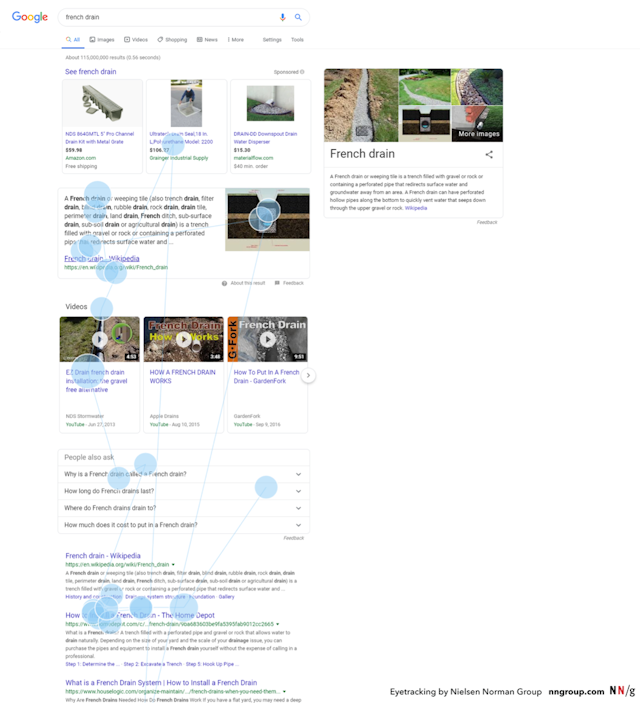Study reveals how users see Google results pages
A new study published by Nielson Norman Group (NN/g) shows how users see and navigate today’s results pages in Google Search. With the old list of ten blue links replaced with a more complex variety of results, users no longer know what they’re going to see after hitting the search button.

Vertical Leap advise marketers on how to make the most of search marketing.
Unpredictable SERPs have changed the way people interact with results pages and how SEOs need to optimise for views and clicks. Here’s a summary of the NN/g study and what its findings mean for search marketers.
Introducing the Pinball Pattern
Previous research from Nielson Norman Group (2013) found that “in 59% of [Google searches], people scanned the SERP sequentially, from the first results, to the second, and so on, without skipping any results or looking at the right side of the page.”

However, the research group finds things have changed drastically in recent years and it’s easy to see why when you compare today’s SERPs with their 2009 ancestors. Now, Nielson Norman Group research finds the sequential scanning that was so common in 2006 is now the exception, not the rule.
The more common user behaviour is something called the Pinball Pattern.

As the NN/g study explains, “Today’s SERPs often involve not only links, but also images, video, embedded text content, and even interactive features. Any given search can return an assortment of different visual elements.”
Humans are visual creatures and the distribution of such elements in the SERPs has a significant impact on how users navigate the page. As a result, organic results near visual elements become more visible while those further away consequently lose visibility.

The NN/g study finds that when featured snippets and other dynamic SERP features are present, they’re seen by users in 74% of cases.
The inconsistency of modern SERPs
The other key influence affecting the way users interact with results pages is the unpredictability of them. Back in 2009, users knew they would see a list of ten organic results for every search query, which made the visual hierarchy of results pages instantly digestible.

Now, though, Google users can be greeted with any combination of results and this inconsistency means they need to work harder to process the information on the page. Not only has the quantity of results types increased, but the combination and layout they can be presented in varies a great deal.
So users are now taking longer to digest the results page in front of them, an average of 5.7 seconds before taking any action, according to NN/g findings.
You don’t always need to be first
So what does all this mean for search marketers? Well, the key takeaway Nielson Norman Group wants you to have from this is that you don’t always need to be in position #1 of the SERPs. Changes in user habits mean that lower positions are more valuable than they have been in the past.
“These results are encouraging for site teams. If your site isn’t ranking in the first position, that isn’t ideal. But as long as you’re appearing near the top (within the first 5 results), you may have around a 10–20% chance of getting a click and anywhere from a 40–80% chance of getting a look.”
You do want to be on the first page, though, as only 2% of users click beyond the first page of results.
SEOs also need to keep in mind that user attention is drawn towards visual and dynamic results like featured snippets, product feeds and local results. This gives a visibility boost to organic listings either side of visual formats which can also increase the chances of views and clicks.
However, the unpredictability of today’s SERPs makes this difficult to optimise for.
Search marketing is becoming more complex
User search habits are clearly becoming more varied and complex. The challenge for SEO is finding the business opportunities among changing user habits and creating ways to optimise for them.
The unpredictable nature of modern SERPs means the rules are changing from one search to another and marketers need to implement data science models to predict where their opportunities are.
For example, the NN/g study only briefly touches on is the challenge of optimising for unpredictable SERPs and even competing with Google’s dynamic listings that often result in zero-click searches. It reveals that lower positions are becoming more valuable but it doesn’t touch on the fact that ranking in position zero is also becoming increasingly important.
What it does illustrate, though, is another aspect of how search marketing is becoming more complex.
Lee Wilson, SEO at Vertical Leap.
Content by The Drum Network member:

Vertical Leap
We are an evidence-led search marketing agency that helps brands get found online, drive qualified traffic to their websites and increase conversions/sales.
To...

